
Anaphylaxis in the Wild: How to Spot It and Stop It
Share
Picture this: You’re deep in the backcountry, soaking in the serenity of nature—birds chirping, wind rustling through the trees. Then, out of nowhere, it hits: hives creeping up your arms, swelling in your face, a tightening in your chest that makes every breath a struggle. This isn’t just a bad day outdoors—it could be anaphylaxis, a rapid, life-threatening allergic reaction that doesn’t mess around. Knowing how to recognize it and respond could mean the difference between walking out of the woods and being carried out. Here’s your guide to staying prepared and acting fast.
⚠️ The Sudden Storm
Anaphylaxis is your body’s immune system hitting the panic button, often triggered by something as simple as a bee sting, a hidden nut in your trail mix, or even an unexpected plant encounter. It escalates quickly—sometimes in minutes—and can shut down your airway, drop your blood pressure, or both. The signs are unmistakable if you know what to look for:
- Hives: Itchy, red welts spreading across your skin.
- Swelling: Lips, tongue, throat, or face ballooning uncomfortably.
- Trouble Breathing: Wheezing, gasping, or a feeling like your throat’s closing up.
- Bonus Red Flags: Dizziness, nausea, or a racing pulse can signal it’s getting serious.
In the wild, where help might be miles away, hesitation isn’t an option.
💉 Step 1: Epinephrine—Your Lifeline
If anaphylaxis strikes, there’s one golden rule: epinephrine first, always. This isn’t the time to second-guess or wait it out. Here’s how to use it:
- Dose: For adults (over 55 lbs), 0.3 mg intramuscularly (IM). For kids (under 55 lbs), 0.15 mg IM. That’s the standard EpiPen or generic auto-injector.
- How: Jab it into the outer thigh—through clothes if needed—hold for 3 seconds, then pull it out.
- Next: Call for help immediately—dial emergency services or trigger your satellite SOS device.
If symptoms don’t ease up within 5-15 minutes (think persistent wheezing or swelling), don’t wait—give a second dose if you’ve got it. Epinephrine buys you time by opening airways and stabilizing blood pressure, but it’s not a cure. You still need medical care.
💊 Step 2: The Backup Plan—Benadryl + Pepcid
Once epinephrine’s in play, you can layer on extra relief to tackle the allergic cascade:
- Benadryl (Diphenhydramine): 25-50 mg (pills or liquid) targets H1 histamine receptors, calming hives and itching.
- Pepcid (Famotidine): 20 mg hits H2 histamine receptors, helping with swelling and stomach upset.
This one-two punch can ease symptoms while you wait for rescue, but it’s not a substitute for epinephrine—it’s a supplement. Keep these in your kit; they’re lightweight and could make a rough wait more bearable.
🆘 The Hidden Danger: Biphasic Reactions
Here’s the kicker: even if you feel better after that first shot, anaphylaxis can come back swinging. Up to 20% of cases see a “biphasic” reaction, where symptoms vanish then roar back within 4 hours—sometimes worse than before. You might think you’re in the clear, then suddenly you’re gasping again. That’s why getting to a doctor isn’t optional, even if you stabilize on the trail. Monitor yourself or your buddy closely: watch for returning hives, breathing issues, or that sinking feeling of dizziness.
✅ Be Ready Before You Go
Anaphylaxis doesn’t care if you’re a seasoned hiker or a weekend warrior—it can happen to anyone, anywhere. Your best defense? Preparation:
- Carry Epinephrine: If you’ve got known allergies, an EpiPen is non-negotiable. Even if you don’t, consider packing one—random triggers like insect bites can surprise you.
- Know the Signs: Train yourself and your crew to spot trouble early.
- Pack Smart: Toss Benadryl and Pepcid in your first-aid kit—they’re cheap, light, and clutch in a pinch.
- Plan for Evacuation: Have a way to call for help, whether it’s a charged phone or a satellite communicator.
The wilderness is full of beauty—and a few risks. At PrepEM Wild, we’re here to equip you with the skills to handle whatever nature throws your way. Anaphylaxis is fast, but you can be faster. Follow us for more tips to keep your adventures safe, and share this with your crew. One quick action could save a life—maybe even yours.


